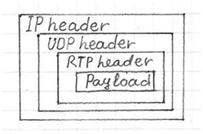Video streaming Protocols RTP, RTCP, RTSP are used to transmit video as data packets over the Internet and other IP networks.
Instead of storing large multimedia files and playing back, multimedia may be sent across the network in streams. The data is organized as a sequence of packets with size suitable for transmission between the servers and clients. When the application plays one packet, the following packets may already be in the stage of decompression or demultiplexing.

RTP (Realtime transport protocol) is a protocol dedicated to the transport of real-time video and audio streams. It can be used for one-way transport such as video-on-demand as well as interactive services such as Internet telephony. RTP provides mechanisms for time reconstruction, loss detection, security and content identification. RTP falls into both the Session Layer (Layer 5) and the Presentation Layer (Layer 6) of the OSI model.
The RTP Control Protocol (RTCP) is an upper-layer companion protocol that allows monitoring of the data delivery. It’s designed to give feedback on the quality of data transmission and information about participants in the on-going session.
The RTP protocol is designed to be used with the Transport Layer UDP/IP protocol. RTP and RTCP packets are encapsulated in UDP/IP packets.